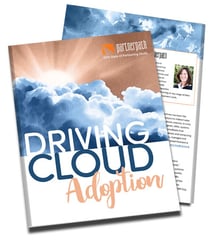Back in 2015, after eight years of talking about the technology industry moving to cloud consumption models, we conducted PartnerPath’s first research on how vendors and solution providers were coping in the transition. This research led to Driving Cloud Transitions, a report which found the on-demand model was producing challenges for both vendor and solution provider partners. Both groups experienced minimal revenue and profitability impact from cloud business models. Partners needed significant help developing profitable and sustainable businesses that highly leverage cloud technologies and on-demand business models.
 Four years later, we are evaluating the progress of transition and, more importantly, the adoption of cloud business models in the channel ecosystem. By all accounts, the acceptance of cloud business models is growing. Both Gartner and IDC expect public and private cloud solution spending to grow aggressively through 2021. IDC is predicting overall spending on cloud IT infrastructure will grow at a 10.9% compound annual growth rate (CAGR) and by 2022 will surpass spending on non-cloud IT infrastructure. The worldwide public cloud services revenues are forecast to reach $302 billion by 2021, according to Gartner, Inc.
Four years later, we are evaluating the progress of transition and, more importantly, the adoption of cloud business models in the channel ecosystem. By all accounts, the acceptance of cloud business models is growing. Both Gartner and IDC expect public and private cloud solution spending to grow aggressively through 2021. IDC is predicting overall spending on cloud IT infrastructure will grow at a 10.9% compound annual growth rate (CAGR) and by 2022 will surpass spending on non-cloud IT infrastructure. The worldwide public cloud services revenues are forecast to reach $302 billion by 2021, according to Gartner, Inc.
The growth of cloud models that both IDC and Gartner are predicting creates two realizations on how products and services are marketed and sold and the role of indirect channels.
Realization #1: Everything is online.
Whether you’re looking for dry-cleaner recommendations from a neighbor on nextdoor.com or making plans for your trip to Italy in six months on tripadvisor.com, everything can be found online. This fact creates two changes for the channel and for vendors that want to engage, empower and evolve their partner ecosystems. For one, it produces well-informed buyers who don’t need channel partners to provide product specifications. They can get near-perfect information about any product or service from a Google search. The second change is that according to Forrester, 73% of new buyers are willing to buy directly from the vendor. The customer doesn’t need a channel partner to procure the product. Like buying CRM from Salesforce.com, anyone can use a credit card and purchase directly from the source. The value of a channel partner shifts from providing product specification and procurement to advising customers and creating solutions to business needs or opportunities.
Realization #2: Cloud consumption models are here to stay.
You can buy anything as a subscription these days. Netflix and Pandora are old hat. You can now have a subscription to AMC theaters or curated shoes delivered monthly. The subscription market has grown by more than 100% a year over the past four years. In the business-to-business world, particularly with software as a subscription like Adobe and DocuSign and storage as a subscription like Dropbox and Box, the buyers are changing. No longer are technical purchases the sole purview of the IT department. Any department head, manager or frankly, authorized credit card holder, can purchase a technology product on a per-seat basis. Forrester cites that 65% of technology decisions are now made by business leaders such as the Chief Marketing Officer or VP of Sales and 29% of those purchases do not involve IT at all. To stay relevant in a subscription-based world, channel partners need to learn how to provide value to these business leaders. They need to be able to explain how they will produce outcomes for business opportunities in less time and on a subscription basis by leveraging cloud-based technologies.
Switching solutions is easy since these products are purchased on a monthly or yearly subscription. As consumers, we know how easy it is to jump from Pandora to Spotify (other than the “stickiness” created by playlists) and to turn off Netflix with a tap of a finger. The measure of success shifts from winning a sale to keeping a customer. Customer churn should be the bellwether for both vendors and solution providers in a cloud consumption model. Therefore, the adoption of a customer success lifecycle methodology ensures profitability growth. Instead of focusing the channel partner ecosystem on closing the deal, forward-looking vendors help partners drive adoption, usage, optimization, growth and renewal of the solution with the end customers.
This blog is an excerpt from the PartnerPath 2019 State of Partnering report: Driving Cloud Adoption. More excerpts will be published in coming months. Be sure to subscribe to our blog below!
What to Do: Align Your Customer Journey
|



